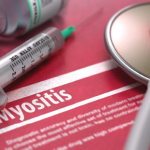Treatment
Dr. Christopher-Stine noted that identifying active disease domains (i.e., skin, muscle, lung or other) in individual patients makes the greatest difference in selecting the appropriate therapy to treat myositis. Treatment options include glucocorticoids, methotrexate, azathioprine, mycophenolate mofetil, rituximab and intravenous immunoglobulin (IVIG).
IVIG has received particular attention since the publication of the ProDERM study. In this study, patients with dermatomyositis on a stable dose of standard therapy (i.e., mycophenolate mofetil, methotrexate, glucocorticoids and/or hydroxychloroquine) were randomized to receive either 2 g/kg of IVIG or placebo every four weeks for 16 weeks. Patients who showed clinical deterioration in this period were switched to the alternative treatment and, at week 16, all patients on placebo and those without clinical deterioration on IVIG received 2 g/kg of IVIG every four weeks for 24 weeks. The study then measured the proportion of responders in each group with at least minimal improvement in the total improvement score (i.e., a composite response criteria) without deterioration at two consecutive visits up to week 16. Researchers found that 79% of patients receiving IVIG and 44% of patients receiving placebo met this end point, respectively.8
In 2021, largely based on these trial results, the U.S. Food & Drug Administration (FDA) approved IVIG for the treatment of adult dermatomyositis. A benefit of the approval has greater insurance coverage for the treatment. However, a downside is that insurance companies are now asking for biopsy proof of myositis even in patients with a clear clinical diagnosis.
In Sum
Dr. Christopher-Stine gave the audience a framework in which to evaluate and care for patients with idiopathic inflammatory myopathies.
Jason Liebowitz, MD, is an assistant professor of medicine in the Division of Rheumatology at Columbia University Vagelos College of Physicians and Surgeons, New York.
References
- Bohan A, Peter JB. Polymyositis and dermatomyositis (first of two parts). N Engl J Med. 1975 Feb 13;292(7):344–347.
- Bohan A, Peter JB. Polymyositis and dermatomyositis (second of two parts). N Engl J Med. 1975 Feb 20;292(8):403–407.
- Oldroyd A, Lilleker J, Chinoy H. Idiopathic inflammatory myopathies—a guide to subtypes, diagnostic approach and treatment. Clin Med (Lond). 2017 Jul;17(4):322–328.
- Cox JT, Gullotti DM, Mecoli CA, et al. “Hiker’s feet”: A novel cutaneous finding in the inflammatory myopathies. Clin Rheumatol. 2017 Jul;36(7):1683–1686.
- Muro Y, Yamashita Y, Koizumi H, et al. Two novel anti-aminoacyl tRNA synthetase antibodies: Autoantibodies against cysteinyl-tRNA synthetase and valyl-tRNA synthetase. Autoimmun Rev. 2022 Dec;21(12):103204
- Fiorentino DF, Mecoli CA, Rosen MC, et al. Immune responses to CCAR1 and other dermatomyositis autoantigens are associated with attenuated cancer emergence. J Clin Invest. 2022 Jan 18;132(2):e150201.
- Oldroyd AGS, Callen JP, Chinoy H, et al. International guideline for idiopathic inflammatory myopathy-associated cancer screening: An international myositis assessment and clinical studies group (IMACS) initiative. Nat Rev Rheumatol. 2023 Dec;19(12):805–817.
- Aggarwal R, Charles-Schoeman C, Schessl J, et al. Trial of intravenous immune globulin in dermatomyositis. N Engl J Med. 2022 Oct 6;387(14):1264–1278.


